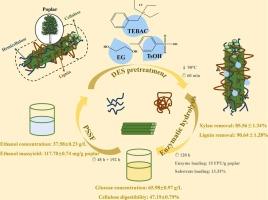Facile fractionation of poplar by a novel ternary deep eutectic solvent (DES) for cellulosic ethanol production under mild pretreatment conditions
IF 5.6
1区 农林科学
Q1 AGRICULTURAL ENGINEERING
引用次数: 0
Abstract
The efficient fractionation of lignocellulosic biomass using deep eutectic solvent (DES) is emerging as an innovative and eco-friendly approach. In this study, a novel ternary DES composed of triethylbenzyl ammonium chloride (TEBAC), p-toluene sulfonic acid (TsOH), and ethylene glycol (EG) was employed for the pretreatment of poplar wood to enhance cellulosic ethanol production. Key pretreatment parameters, including temperature, DES molar ratios, and reaction time, were systematically optimized. Under optimal conditions (90 ºC, 60 min, TEBAC/TsOH/EG ratio of 1:1.5:3) lignin removal reached 90.64±1.28 % and xylan removal achieved 85.56±1.34 %, significantly improving cellulose digestibility. The improvement might be attributed to the removal of hemicellulose and lignin, which exposed cellulose and enhanced the accessibility of cellulase to cellulose. Additionally, optimized enzymatic hydrolysis yielded a glucose concentration of 65.98±0.97 g/L using an enzyme loading of 15 FPU/g poplar and a solid loading of 13.33 %. Furthermore, during pre-hydrolysis combined with simultaneous saccharification and fermentation (PSSF), an ethanol concentration of 37.58±0.23 g/L was achieved. Overall, this study demonstrates a novel ternary DES pretreatment method that effectively facilitates the fractionation and conversion of woody biomass into cellulosic ethanol.

在温和的预处理条件下,使用新型三元深共晶溶剂 (DES) 方便地分馏杨木,以生产纤维素乙醇
使用深共晶溶剂(DES)高效分馏木质纤维素生物质正在成为一种创新的环保方法。本研究采用由三乙基苄基氯化铵(TEBAC)、对甲苯磺酸(TsOH)和乙二醇(EG)组成的新型三元 DES 对杨木进行预处理,以提高纤维素乙醇的产量。对包括温度、DES 摩尔比和反应时间在内的关键预处理参数进行了系统优化。在最佳条件下(90 ºC、60 分钟、TEBAC/TsOH/EG 比为 1:1.5:3),木质素去除率达到 90.64±1.28%,木聚糖去除率达到 85.56±1.34%,显著提高了纤维素消化率。这种改善可能是由于半纤维素和木质素的去除,使纤维素暴露出来,提高了纤维素酶对纤维素的可及性。此外,在酶载量为 15 FPU/g 杨树和固体载量为 13.33 % 的情况下,优化酶水解产生的葡萄糖浓度为 65.98±0.97 g/L。此外,在预水解结合同步糖化和发酵(PSSF)过程中,乙醇浓度达到 37.58±0.23 g/L。总之,本研究展示了一种新型的三元 DES 预处理方法,可有效促进木质生物质的分馏和转化为纤维素乙醇。
本文章由计算机程序翻译,如有差异,请以英文原文为准。
求助全文
约1分钟内获得全文
求助全文
来源期刊

Industrial Crops and Products
农林科学-农业工程
CiteScore
9.50
自引率
8.50%
发文量
1518
审稿时长
43 days
期刊介绍:
Industrial Crops and Products is an International Journal publishing academic and industrial research on industrial (defined as non-food/non-feed) crops and products. Papers concern both crop-oriented and bio-based materials from crops-oriented research, and should be of interest to an international audience, hypothesis driven, and where comparisons are made statistics performed.
 求助内容:
求助内容: 应助结果提醒方式:
应助结果提醒方式:


